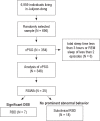REM sleep behavior disorder in the Korean elderly population: prevalence and clinical characteristics
- PMID: 23904674
- PMCID: PMC3700711
- DOI: 10.5665/sleep.2874
REM sleep behavior disorder in the Korean elderly population: prevalence and clinical characteristics
Abstract
Study objectives: To examine the prevalence and clinical characteristics of REM sleep behavior disorder (RBD) and subclinical RBD in the Korean elderly population.
Design: A community-based Korean Longitudinal Study on Cognitive Aging and Dementia and time-synchronized video-polysomnography (vPSG) in a laboratory.
Setting: Sleep laboratory in a university hospital.
Participants: 348 individuals aged 60 years or older.
Intervention: N/A.
Measurements and results: Among 696 subjects who were invited to participate in a vPSG study, 348 completed the vPSG. RBD was diagnosed when subjects showed REM sleep without atonia (RSWA) in the vPSG, and had history of complex and vigorous behaviors during sleep or abnormal REM sleep behaviors in the vPSG. Subjects with RSWA but no abnormal REM sleep behaviors were diagnosed with subclinical RBD. Seven subjects (5 male, 2 female) had RBD, three of whom (1 male, 2 female) had Parkinson disease. Two subjects reported history of sleep-related injury. The crude prevalence of RBD and idiopathic RBD was 2.01% (95% confidence interval [CI] = 0.54% to 3.49%) and 1.15% (95% CI = 0.03% to 2.27%). An age and sex-adjusted prevalence estimate of RBD and idiopathic RBD in the Korean elderly was 2.01% and 1.34%. Eighteen subjects were diagnosed with subclinical RBD, and the prevalence of subclinical RBD was estimated to be 4.95%.
Conclusions: RBD and subclinical RBD are not rare in the elderly in the community with abnormal REM sleep behaviors of RBD being mild to injurious and violent. The clinical significance and long-term progression of subclinical RBD needs to be further explored, given the prevalence and its possible relation to RBD.
Keywords: REM sleep behavior disorder; prevalence; subclinical REM sleep behavior disorder.
Figures
Comment in
-
REM sleep behavior disorder: from epidemiology to heterogeneity.Sleep. 2013 Aug 1;36(8):1117-9. doi: 10.5665/sleep.2860. Sleep. 2013. PMID: 23904667 Free PMC article. No abstract available.
References
-
- Schenck CH, Hurwitz TD, Mahowald MW. Symposium: Normal and abnormal REM sleep regulation: REM sleep behaviour disorder: an update on a series of 96 patients and a review of the world literature. J Sleep Res. 1993;2:224–31. - PubMed
-
- Schenck CH, Mahowald MW. REM sleep behavior disorder: clinical, developmental, and neuroscience perspectives 16 years after its formal identification in SLEEP. Sleep. 2002;25:120–38. - PubMed
-
- Bonakis A, Howard RS, Ebrahim IO, Merritt S, Williams A. REM sleep behaviour disorder (RBD) and its associations in young patients. Sleep Med. 2009;10:641–5. - PubMed
-
- Lin FC, Lai CL, Huang P, Liu CK, Hsu CY. The rapid-eye-movement sleep behavior disorder in Chinese-Taiwanese patients. Psychiatry Clin Neurosci. 2009;63:557–62. - PubMed
-
- Olson EJ, Boeve BF, Silber MH. Rapid eye movement sleep behaviour disorder: demographic, clinical and laboratory findings in 93 cases. Brain. 2000;123:331–9. - PubMed
Publication types
MeSH terms
LinkOut - more resources
Full Text Sources
Other Literature Sources
Medical


